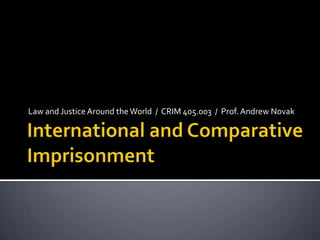
International and comparative imprisonment
- 1. Law and Justice Around the World / CRIM 405.003 / Prof. Andrew Novak
- 2. Placing imprisonment in context The problem of prison conditions: What harm does it cause? (Thailand video clip) Women in prison (South Africa video clip) Private prisons: What role should there be? (Oklahoma video clip) Prison reform: Hope for resource-constrained legal systems? (India video clip)
- 3. Today, imprisonment is the paradigmatic criminal punishment around which all of the world’s correctional systems are built While prisons have existed for centuries, they were typically holding tanks for other criminal punishments and not punishments in themselves until after 1800 Replaced transportation to a penal colony and punishments of the body as typical punishment In most of the world, imprisonment is entering a period of crisis as more crimes are punished, and punished more harshly Virtually every country in the world wrestles with prison overcrowding and conditions
- 4. Our model countries: United Kingdom ▪ Highest number of inmates in Western and Northern Europe ▪ Development of independent monitoring boards composed of volunteers, which visit prisons and report on conditions and crowding situations France ▪ Persistent problem of lengthy pre-trial detention (characteristic of civil law countries) ▪ Lags behind rest of Europe in promoting alternatives to incarceration ▪ Development of “corrections judges” to hear prisoner complaints and conduct tours
- 5. Our model countries Germany ▪ Extensive use of rehabilitation programs; clear leader in Europe of alternatives to incarceration ▪ Progressive penal philosophy characteristic of Northern Europe ▪ Inmates have access to courts and special panels hear grievances Saudi Arabia ▪ Because of dominant retributive philosophy, prison conditions are poor and oversight is minimal ▪ Highest prison rate (out of 100,000 people) of any of the model countries, but much lower than the United States (173 out of 100,000 versus 730 out of 100,000)
- 6. Our model countries China ▪ Emphasis on prison labor in all forms of incarceration; serves both rehabilitative and propaganda purposes ▪ Administrative detention: allow brief periods of imprisonment for minor crimes without trial Japan ▪ Individualized treatment includes strong emphasis on rehabilitation ▪ Problems of prison gangs, mistreatment of prisoners ▪ Imprisonment is considered disgrace to family and community and is a highly exceptional punishment (by far the lowest prison rate of our model countries, 55 per 100,000)
- 7. United Nations “soft law” documents Example: UN Standard Minimum Rules for the Treatment of Prisoners (1955) “Bangkok Hilton” – Bang Kwang Prison in Bangkok, Thailand: http://www.youtube.com/watch?v=aFo8P7R G5Fw
- 8. Recent concern over the special problems facing incarcerated women, including 2010 approval of the UN’s “Bangkok Rules” One example of the special problems faced by women in prison settings: What should we do with incarcerated women with newborn or nursing infants or very small children? Most countries (but not most of the United States) allow very young children to remain with their mother in prison http://www.youtube.com/watch?v=3K40gc6XC3 c
- 9. Private prisons: correctional institutions that are operated by private firms under government contract In the United States, abut 4% of prisoners are held in private prisons, most run by the Corrections Corporation of America or the GEO Group (formerly Wackenhut Corp.) Operating in many Western countries, but unconstitutional in some http://www.youtube.com/watch?v=zwTk2E8S78
- 10. Resource-constrained legal systems, especially in the developing/postcolonial world, face crisis most acutely African Prisons Project: http://www.africanprisons.org/ International Centre for Prison Studies: www.prisonstudies.org India video clip: http://www.youtube.com/watch?v=iaLzI3aN NWU
